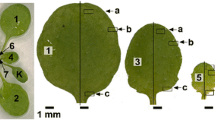Summary
Observations by light, transmission electron and scanning electron microscopy have shown that intercellular spaces (ICS) are formed schizogenously in expanding leaves ofPhaseolus vulgaris. ICS formation occurs in predictable positions at the junctions between three or more cells, and follows three phases of development. The first, initiation, phase occurs soon after cell division, and is marked by the formation of an electron-dense osmiophilic body, probably proteinaceous, at the end of the cell plate/middle lamella of the daughter cell wall and across the adjacent piece of the primary wall of the mother cell. This part of the mother cell wall is digested, involving cellulolysis. The second phase, of cell separation, is marked by the first appearance of the ICS. InPhaseolus primary leaves this phase begins about day 3 after sowing, at which time the leaf area is about 1 cm2. In the final enlargement phase, lysis of cell wall material continues in the region of the middle lamella, and mechanical tensions arising from the rapid expansion of the lamina lead to further separation of the mesophyll cells so that spaces enlarge and merge.
Similar content being viewed by others
References
Avery GS (1933) Structure and development of the tobacco leaf. Am J Bot 20: 565–592
Briarty LG (1980) Stereological analysis of cotyledon cell development inPhaseolus II. The developing cotyledon. J exp Bot 31: 1387–1398
Carr SGM, Carr DJ (1975) Intercellular pectic strands in parenchyma: studies of plant cell walls by scanning electron microscopy. Aust J Bot 23: 95–105
Cutter EG (1971) Plant anatomy. Part 2. Organs. Edward Arnold, Contemporary Biology Series
Dale JE (1964) Leaf growth inPhaseolus vulgaris. I. Growth of the first pair of leaves under constant conditions. Ann Bot 28: 579–590
— 1976: Cell division in leaves. In:Yeoman MM (ed) Cell division in higher plants. Academic Press, New York, pp 314–345
De Chalain TMB, Berjak P (1979) Cell death as a functional event in the development of leaf intercellular spaces inAvicennia marina (Forsskal) Vierh. New Phytol 83: 147–155
Dengler NG, Mackay LB, Gregory LM (1975) Cell enlargement and tissue differentiation during leaf expansion in Beech,Fagus grandifolia. Can J Bot 53: 2846–2865
James J,Tas J (1984) Histochemical protein staining methods. Oxford University Press
Kawase M (1979) Role of cellulase in aerenchyma development in sunflower. Am J Bot 66: 183–190
Karnovsky MJ (1979) A formaldehyde-glutaraldehyde fixative of high osmolarity for use in electron microscopy. J Cell Biol 27: 137A
Kollöffel C, Linssen PWT (1984) The formation of intercellular spaces in the cotyledons of developing and germinating pea seeds. Protoplasma 120: 12–19
Lienart Y, Barnoud F (1985) β-D-Glucanohydrolase activities in pure cell-wall-enriched fractions fromValerianella olitoria cells. Planta 165: 68–75
Martens P (1937) L'origine des espaces intercellulaires. La Cellule 46: 355–388
Pfeffer W (1903) The physiology of plants, Vol 2. Translated by AJ Ewart. Oxford University Press
Reynolds ES (1963) The use of lead citrate at high pH as an electron opaque stain in electron microscopy. J Cell Biol 17: 208
Roland J-C (1978) Cell wall differentiation and stages involved with intercellular gas space opening. J Cell Sci 32: 325–336
Sifton HB (1940) Lysigenous air spaces in the leaf of Labrador tea,Ledum groenlandicum Oeder. New Phytol 39: 75–79
— (1945) Air-space tissue in plants. Bot Rev 11: 108–144
— (1957) Air-space tissue in plants. II. Bot Rev 23: 303–312
Spurr AR (1969) A low viscosity epoxy resin embedding medium for electron microscopy. J Ultrastruct Res 26: 31–43
Tas J, van der Ploeg M, Mitchell JP, Cohn NS (1980) Protein staining methods in quantitative cytochemistry. J Microsc 119: 295–311
Thiéry JP (1967) Mise en évidence des polysaccharides sur coupes fines en microscopie électronique. J Microscopie 6: 987–1018
Van Volkenburgh E, Cleland RE (1980) Proton excretion and cell expansion in bean leaves. Planta 148: 273–278
— — (1981) Control of light-induced bean leaf expansion: role of osmotic potential, wall yield stress, and hydraulic conductivity. Planta 153: 572–577
—,Schmidt MG, Cleland RE (1985) Loss of capacity for acid-induced wall loosening as the principal cause of the cessation of cell enlargement in light-grown bean leaves. Planta 163: 500–505
Veres JS, Williams GJ (1985) Leaf cavity size, differentiation and water relations inCarex eleocharis. Am J Bot 72: 1074–1077
Author information
Authors and Affiliations
Rights and permissions
About this article
Cite this article
Jeffree, C.E., Dale, J.E. & Fry, S.C. The genesis of intercellular spaces in developing leaves ofPhaseolus vulgaris L.. Protoplasma 132, 90–98 (1986). https://doi.org/10.1007/BF01275795
Received:
Accepted:
Issue Date:
DOI: https://doi.org/10.1007/BF01275795




